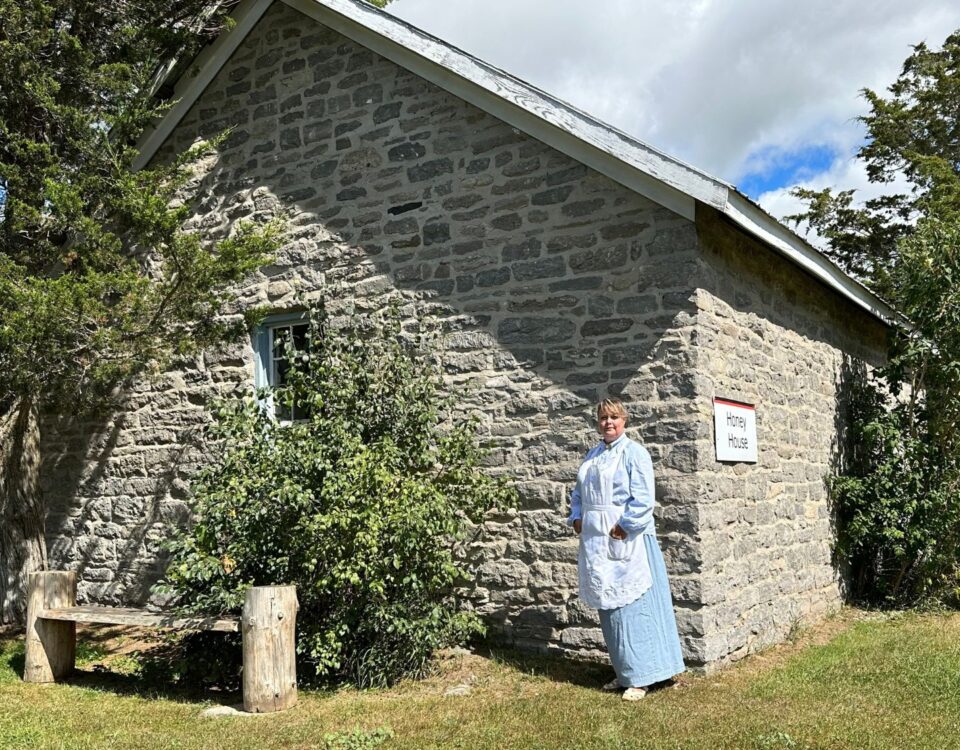Ameliasburgh Museum
Ameliasburgh Heritage Village: A Respite from the Wineries
Prince Edward County
By Ardith Racey

Today, Prince Edward County has over 40 wineries, but this was not always the case. The county has always been an agricultural hub, and in the 1930’s and 40’s when it was called “the Garden County of Canada”, there were 77 canneries in operation. The history of the canneries forms only a fraction of the extensive memorabilia that featured at the Ameliasburgh Heritage Village.
Janice Hubbs, curator of the ‘Village’, is a storyteller who has learned the stories of the county through donations of local artefacts – the place is now more than a museum – it’s a themed grouping of replica buildings brimming with history that offers a reprieve from the wineries and beaches for which the County is better known. Tucked away in the village of Ameliasburgh and situated close to Roblin Lake, the ‘Village’ offers a fascinating look at life in the late 19th and early 20th centuries.
In 1968, the Ameliasburgh United Church was designated by the community as a museum: it was formerly a Wesleyan Methodist Church built in 1868 and which boasts the “highest steeple in Prince Edward County. It now houses everything from quilts to old pianos, as well as a ‘barn loom’. Over the years, additional buildings have been added – there’s a furnished log cabin, several display barns that showcase old buggies, sleighs, and farm equipment, an operational blacksmith shop, a carpenters’ shop, maple syrup and beekeeping buildings, and an impressive engine house that houses a huge flywheel once used to power the Hancock Lumber Co mill in Carrying Place. Two of the buildings were constructed from limestone taken from the crumbling Roblin’s Mill which was originally built in 1842.
In addition to the donation of “so many old things”, local support for the ‘Village’ has been extensive. The ‘Honey House’ is one of those buildings which was moved to the site in 1978 via support of the Quinte Beekeepers Association. The ‘Log Cabin’ is an original cabin from Ameliasburgh Township which was reassembled on site in 1969 with support of the Loyalist Timber Framing company.
Hubbs estimates that in addition to about 15 school group visits, roughly 7,000 people visit the site annually, “usually on days when they can’t go to the beach.” There’s a strong sense of community that values agriculture as a way of life evident in each of the buildings’ exhibits. Hubbs dresses in period costume each day and tries to make the school tours engaging and interactive but leaves the ‘tourists’ to self-guided meandering.
With the occasional support of a student in the summer, Hubbs has single-handedly created a venue that is sure to fascinate history buffs, agriculture enthusiasts, as well as anyone interested in taxidermy. The Devries Natural Heritage Collection is an impressive preservation of the biodiversity of the area which was supported, in part, by the Parrott Foundation. The collection contains hundreds of lifelike representations of birds, mammals, and fish which were created by the late Jake Devries. It’s truly something else!
So, if you’re looking for a respite from the county’s wineries, beaches, and art galleries, a few hours in the ‘Village’ will ignite your sense of heritage.
For more articles read the full magazine on Issuu


